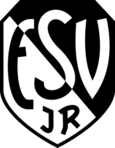ESV Ingolstadt
 |
|
| Full name | Eisenbahner Sport Verein Ingolstadt-Ringsee e. V. |
|---|---|
| Founded | 15 February 1919 |
| Ground | ESV-Stadion |
| Capacity | 16,500 seats |
| Chairman | Karl Kunz |
| League | football department defunct |
The ESV Ingolstadt is a general sports club in Ingolstadt, Bavaria, formed on 15 February 1919.
Until 2004, the club operated a football department but after a merger with local rival MTV Ingolstadt to form FC Ingolstadt 04 the footballers left for the new club.
The club has over 1,600 members in 21 sports departments. The club is associated with the German railways, as evident by the term railway sports club in its name (German: Eisenbahner Sportverein), and is a member of the Association of German railway sports clubs, the VDES.
The earliest origins of the club lay in 1912, with the Sängerverein Ringsee, a local choir. Upon the end of the First World War, a large number of clubs and associations were formed in Ingolstadt and the quite a few of them eventually merged over time to form the ESV. In 1920, the following five clubs merged into the Turnverein Ringsee:
The TVR in turn was renamed RTSV Ingolstadt-Ringsee in 1930, RSG Ingolstadt in 1940 and, finally, TSV Ingolstadt-Ringsee in 1945.
As far as sport, and therefore football is concerned, the ESV's foundation date results from the formation of the FC Viktoria Ingolstadt in 1919. Another sports club, the VfR Ingolstadt, was formed in 1921. These two clubs merged in 1925 to form the VfB Ingolstadt-Ringsee. It is also this club who had by far the most success on the football field in the pre-Second World War years.
In 1946, the TSV Ingolstadt-Ringsee and VfB Ingolstadt-Ringsee merged to form VfL Ingolstadt-Ringsee. In 1951, this club was renamed ESV Ingolstadt Ringsee but until 1953, the E in the club name stood for Erster (English: First). In 1953, this was changed to Eisenbahner (Railway) to reflect that the club was now affiliated with the German railways Deutsche Bahn.
The club first appears on the map of German league football in 1930, when VfB Ingolstadt-Ringsee earned promotion to the Bezirksliga Bayern, then the highest league in the region. After two seasons in this league fighting relegation, the team dropped back into the second tier in 1932. A return to first division football was made in 1936, when it won promotion to what was now the Gauliga Bayern, introduced by the Nazis in 1933. Again, the club was only good for two seasons and then disappeared from this level. It made one more return in 1943, now as KSG Ingolstadt, a war time merger with the MTV.
...
Wikipedia
